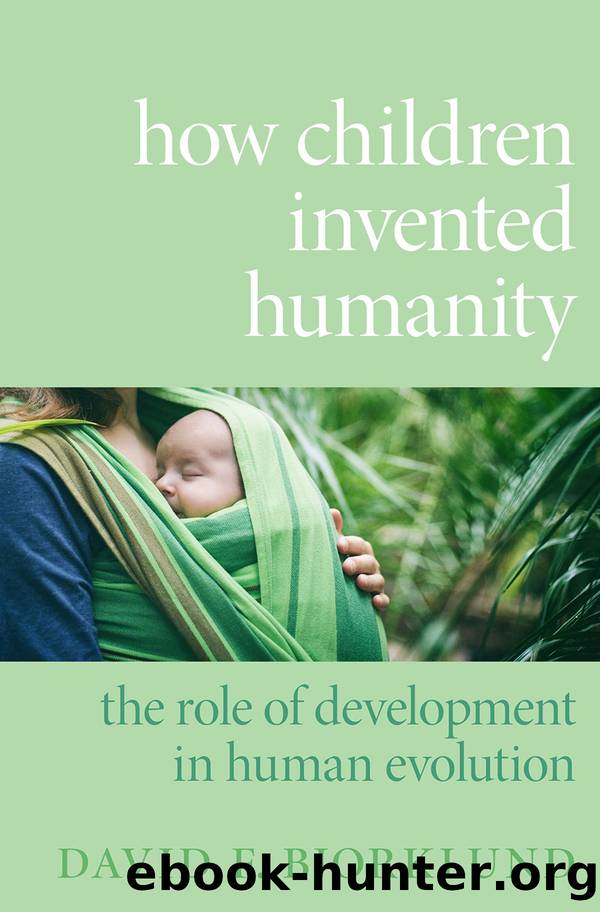How Children Invented Humanity by David F. Bjorklund

Author:David F. Bjorklund
Language: eng
Format: epub
Publisher: Oxford University Press
Published: 2020-10-15T00:00:00+00:00
Figure 6.5. Chimpanzees are highly social animals, but their social cognition is qualitatively different from that of Homo sapiens.
Source: Shutterstock, with permission.
Empathy
Much like the emotion of jealousy described earlier, empathy is usually thought of as a secondary emotion that requires a certain level of cognitive sophistication not available to children much before the age of 2. At its broadest level, empathy refers to the ability to recognize, perceive, and feel the emotion of another. At a minimum, empathy requires the ability to take the perspective of another. Perspective taking is not an all-or-none thing, however, but develops gradually over infancy and childhood. For example, babies need some level of perspective taking to participate in shared-attention routines with adults, beginning around 9 months of age. Yet the ability to take the emotional and cognitive perspective of another continues to develop well into the childhood years as evidenced, for instance, by childrenâs failure to pass conventional false-belief tasks until about the age of 4. As childrenâs perspective-taking skills improve, so does their ability to experience empathy.
One early-developing forms of empathy is seen in newborns. Several studies have reported that infants as young as 3 days old will begin to cry and show signs of distress when they hear the cries of another infant, although not when they hear an artificial simulation of a babyâs cry.77 During the toddler years, children are able to recognize and often react to the distress of others, although they do not fully understand the internal state of others and assume it is the same as their own. For example, a 2-year-old boy may give his tearful mother a teddy bear because it comforts him when he is sad. With age and improved perspective-taking abilities, children are increasingly able identify the emotions others are expressing and to realize that other peopleâs perspectives and feelings may be different from their own.78
What about apes? Primatologists Stephanie Preston and Franz de Waal proposed that there are different types of empathy, some of which are shown by great apes. The type of empathy that typifies humans, in which someone recognizes another personâs emotional state, is referred to as cognitive empathy; it requires advanced perspective-taking skills, and this seems not to be expressed by chimpanzees and the other great apes. Yet, Preston and de Waal propose that great apes display simpler forms of empathy, such as emotional contagion (similar to that shown by newborns hearing the cries of other babies), sympathy, and, in some contexts, even cognitive empathy.79 As an example, de Waal relates an incident in which an 8-year-old female gorilla helped a 3-year-old boy who fell into the primatesâ cage at the Chicago Brookfield Zoo, and another in which a long-time human researcher at the Stuttgart Zoo introduced her newborn baby to the bonobos, upon which the alpha female left briefly and returned with her own newborn.80 Yet, in laboratory settings chimpanzees seem to be indifferent to the welfare of others. For instance, chimpanzees usually fail to provide food to other familiar but unrelated chimps, even though there is no material cost to themselves.
Download
This site does not store any files on its server. We only index and link to content provided by other sites. Please contact the content providers to delete copyright contents if any and email us, we'll remove relevant links or contents immediately.
| Administration & Medicine Economics | Allied Health Professions |
| Basic Sciences | Dentistry |
| History | Medical Informatics |
| Medicine | Nursing |
| Pharmacology | Psychology |
| Research | Veterinary Medicine |
Bioenergetica by Alexander Lowen(1124)
Noise: A Flaw in Human Judgment by Sunstein Cass R. & Sibony Olivier & Kahneman Daniel(968)
The Data Detective by Tim Harford(947)
The Child in You by Stefanie Stahl(883)
Chatter by Ethan Kross(799)
The Science of Rapid Skill Acquisition by Peter Hollins(639)
Freedom by Sebastian Junger(633)
No Bad Parts by Richard C. Schwartz(608)
The Montessori Baby by Simone Davies(566)
Evolution Gone Wrong: The Curious Reasons Why Our Bodies Work by Alex Bezzerides(560)
The Quantum Psychiatrist: From Zero to Zen Using Evidence-Based Solutions Beyond Medication and Therapy by Biswas Dona(551)
Maps of Meaning: The Architecture of Belief by Jordan B. Peterson(551)
The Science of Self-Learning: How to Teach Yourself Anything, Learn More in Less Time, and Direct Your Own Education (Learning how to Learn Book 1) by Peter Hollins(522)
Anxiety For Dummies by Charles H. Elliott & Laura L. Smith(513)
Sadomasochism and the BDSM Community in the United States by Stephen K. Stein(498)
Disconnected by thomas Kersting(482)
Why Sex Doesn't Matter by Olivia Fane(481)
The Mechanics of Passions: Brain, Behaviour, and Society by Alain Ehrenberg(480)
Jung - The Key Ideas: Teach Yourself (TY Philosophy) by Ruth Snowden(468)
